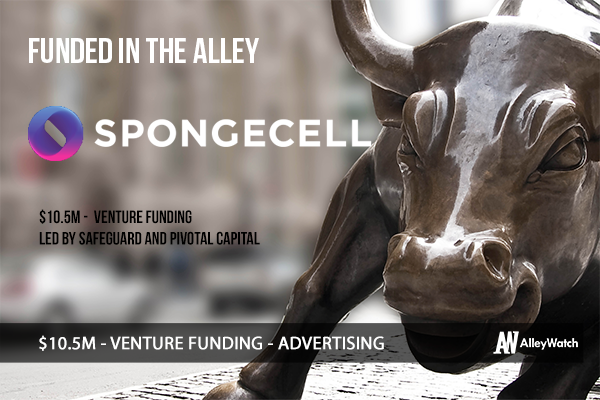 Display advertising is taking a larger share of ad spends each. With this burgeoning market, the use of the right creative is critical. Spongecell, with their CORE technology, is providing brands the opportunity to target customers in smarter and effective ways with the development of smart creatives. The company uses data to drive the creation of your creative set and is now being used by 60% of Fortune 100 companies.
Display advertising is taking a larger share of ad spends each. With this burgeoning market, the use of the right creative is critical. Spongecell, with their CORE technology, is providing brands the opportunity to target customers in smarter and effective ways with the development of smart creatives. The company uses data to drive the creation of your creative set and is now being used by 60% of Fortune 100 companies.
AlleyWatch spoke with CEO Ben Kartzman about the company’s origins as well as their most recent round of funding.
Who were your investors and how much did you raise?
We raised $10.5M from Safeguard and Pivotal Capital.
Tell us about your product or service.
Spongecell’s CORE (Creative Optimization Relevance Engine) allows brands to serve smarter, data-driven creative and to streamline the creative build process to maximize efficiencies. By integrating data, machine learning and automation in the creative process, we enable marketers to efficiently deliver more resonant brand experiences in their digital advertising. Our platform offers the most flexible methodology to set up complex marketing strategies through an elegant and intuitive interface. Clients can make changes to targeting or creative on the fly without the need to retraffic. Our dynamic creative studio was built from the ground up to maximize production efficiencies. We offer over 20 training courses to get clients quickly transitioned to self service. This degree of control, transparency and efficiency for sophisticated marketers is unparalleled.
What inspired you to start the company?
We saw an opportunity to bring creative to programmatic. In 2009, no one was talking about the role creative would play in a data-driven world. That was our initial focus and we continue down the path of forging smarter programmatic creative.
How is it different?
Programmatic creative advertisers must employ a platform comprised of both a CMP and a DCO. The Spongecell CORE’s CMP and DCO functionalities work in tandem to generate the most sophisticated creative versions that are truly personalized based on the data feedback loop. Our dynamic creative studio’s clean UX was built from the ground up to build dynamic creative for mobile, display and video. Spongecell’s decision engine provides the most flexible methodology to set up complex marketing strategies through an elegant and intuitive interface. Clients can change on the fly without the need to retraffic. Our fast, efficient and reliable product catalog onboarding system updates in real-time to power our advanced product recommendation. For our self-service clients, we’ve developed an operational methodology consisting of over 20 training courses ranging from platform overview to advanced dynamic setups.
What market you are targeting and how big is it?
We believe all creative should be data driven, we believe our product can support that. It’s a multi-billion-dollar opportunity.
What’s your business model?
We sell software. Our clients use our platform, typically on an annual basis, to drive meaningful results across a multitude of their initiatives.
What are the pros and cons to providing a self learning service?
Some clients want control and don’t want the algorithm to do work—we allow for this. On the other hand, we strongly encourage clients allow the algorithm to optimize creatives for best performance.
What was the funding process like?
We’re fortunate in that we have a software model and not a media arbitrage model. That’s something that is attractive to investors.
What are the biggest challenges that you faced while raising capital?
Investors are skeptical about the marketing of tech platforms, but once they were able to look under the hood and see the elegant architecture and unparalleled utility of the UI of the platform, they were blown away.
What factors about your business led your investors to write the check?
They were also impressed with our great team, top clients and the best tech in the market.
What are the milestones you plan to achieve in the next six months?
Discovery Tags:
To help marketers glean deeper insights from their campaigns, Spongecell’s CORE will look for targeting opportunities beyond a campaign’s preconceived rules. At the time of ad impression, CORE will collect data points beyond those predetermined for creative targeting to provide additional optimization opportunities by considering all possible dynamic signals simultaneously. Marketers will better understand what factors impacted campaign results, and can use these learnings to influence creative and media decisions moving forward.
Targeting Groups:
In order to provide clients deeper insights into campaign performance, Spongecell is developing a new Targeting Group reporting capability. Clients will have access to a custom report by creative and targeting group (for example, conversions from a specific audience segment and geo), even if this targeting group was not specified at campaign setup. Clients can filter by targeting group to see which ones are performing the best.
What advice can you offer companies in New York that do not have a fresh injection of capital in the bank?
Always focus on delivering for your customers and things will fall into place.
Where do you see the company going now over the near term?
We are going to stay laser focused on partnering with the best clients in the world to deliver more personalized creative at scale.
Where is your favorite bar in the city for an after work drink?
Gabriel Kreuther in the Grace Building.



